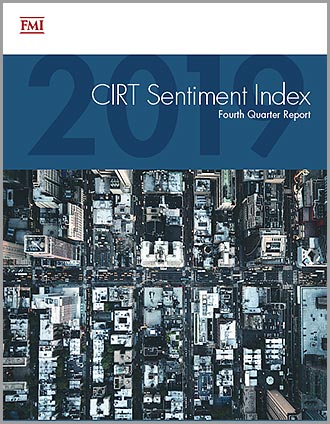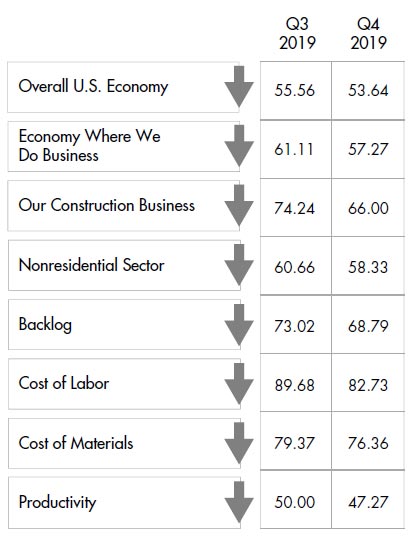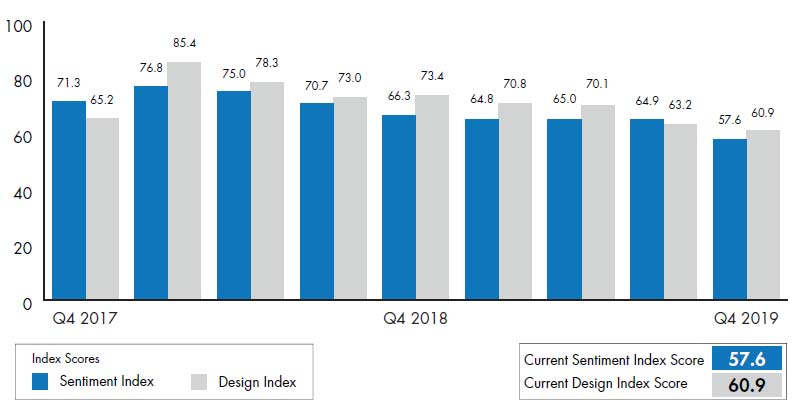2019 CIRT Sentiment Index: Fourth Quarter Report

INDEX MOVEMENT

In comparison with the last quarter, the fourth quarter of 2019 showed a pronounced decrease in the CIRT Sentiment Index as well as some decline in the Design Index. The CIRT Sentiment Index fell from 64.9 to 57.6, whereas the Design Index reflected a less dramatic loss, from 63.2 to 60.9. The downward trend in the scores represents the elusiveness of the market leading into 2020.
This quarter our current trends questions focused on positive and negative impacts that could affect the U.S. economic and business conditions leading into 2020. Overall, respondents believe that U.S. monetary policy, the results of the U.S. presidential and congressional elections, and private sector investments are the top three factors that could influence a positive economic climate. In comparison, the U.S. presidential and congressional elections, trade agreements and unemployment rates were identified as the top three factors that could influence a negative economic climate in 2020.
This survey revealed that more than three-fourths of responding CIRT member companies, or 83%, consider external threats when reviewing strategic plans of yearly goals and objectives. Of those companies that consider these threats, the majority, or 69%, focus on trends that affect the specific sector(s) they work in. Following, 44% of respondents consider private sector investments, 44% pay attention to the impact of U.S elections, 41% watch for the impact of unemployment rates, 39% watch for trade agreement changes, and 37% monitor cost spikes. With other factors, such as an anticipated recession in 2021, most CIRT companies are trying to look ahead to ensure these factors and threats are manageable.
Among the segments and industries represented by CIRT’s member base, the industrial sector is projected to experience the most short-term growth across the broader construction industry, whereas industrial, public works and transportation sectors are all expected to grow and remain healthy over the long term. Secondary segments, which all stand out as stable over the next year, include health care, international and education. Design respondents expect transportation and health care to outperform over the next quarter. Similar to construction findings, the design respondents see long-term opportunities in health care, transportation and education.
Overall, across the construction industry, respondents believe that industrial, transportation and public works sectors are showing the most promise long-term. Commercial will remain steady, and lodging, manufacturing and office will decline over the next year. Within the design industry, respondents believe that commercial, consulting planning, heavy/civil and residential will decline; industrial and pre-design work will be stable; and health care, education and transportation will experience growth over the long term.
CIRT SENTIMENT INDEX AND DESIGN INDEX SCORES FROM Q4 2017 TO Q4 2019

To access the full report including all charts and graphs, please download the PDF.
ABOUT THE CONSTRUCTION INDUSTRY ROUND TABLE (CIRT)
The Construction Industry Round Table (CIRT) is composed exclusively of approximately 115-120 CEOs from the leading architectural, engineering and construction firms doing business in the United States.
CIRT is the only organization that is uniquely situated as a single voice representing the richly diverse and dynamic design/construction community. First organized in 1987 as the Construction Industry Presidents’ Forum, the Forum has since been incorporated as a not-for-profit association with the mission “to be a leading force for positive change in the design/construction industry while helping members improve the overall performance of their individual companies.”
The Round Table strives to create one voice to meet the interests and needs of the design/construction community. CIRT supports its members by actively representing the industry on public policy issues, by improving the image and presence of its leading members, and by providing a forum for enhancing and developing strong management approaches through networking and peer interaction.
The Round Table’s member CEOs serve as prime sources of information, news and background on the design/construction industry and its activities. If you are interested in obtaining more information about the Construction Industry Round Table, please call 202-466-6777 or contact us by email at [email protected].
CIRT SENTIMENT INDEX
The CIRT Sentiment Index is a survey of members of the Construction Industry Round Table conducted quarterly by FMI Research, Raleigh, North Carolina. For press contact or questions about the CIRT Sentiment Index, contact Mark Casso at [email protected] or Brian Strawberry at [email protected].
All individual responses to this survey will be confidential and shared outside of FMI only in the aggregate.
All names of individuals responding to this survey will remain confidential to FMI.
 Brian Strawberry is a senior economist with FMI. Brian’s expertise is in economic and statistical modeling. He leads FMI’s efforts in market sizing, forecasting, and building product/construction material pricing and consumption trends. The combination of Brian’s analytical skills and creative problem-solving abilities has proven valuable for many contractors, owners and private equity groups as well as industry associations and internal research initiatives. Brian can be reached at [email protected].
Brian Strawberry is a senior economist with FMI. Brian’s expertise is in economic and statistical modeling. He leads FMI’s efforts in market sizing, forecasting, and building product/construction material pricing and consumption trends. The combination of Brian’s analytical skills and creative problem-solving abilities has proven valuable for many contractors, owners and private equity groups as well as industry associations and internal research initiatives. Brian can be reached at [email protected]. Caroline Bell is a research analyst with FMI. She conducts primary and secondary research for FMI’s clients focused in the construction and engineering industries. Caroline’s responsibilities include conducting interviews with subject matter experts, designing surveys and analyzing data gathered through market research. Caroline can be reached at [email protected].
Caroline Bell is a research analyst with FMI. She conducts primary and secondary research for FMI’s clients focused in the construction and engineering industries. Caroline’s responsibilities include conducting interviews with subject matter experts, designing surveys and analyzing data gathered through market research. Caroline can be reached at [email protected].